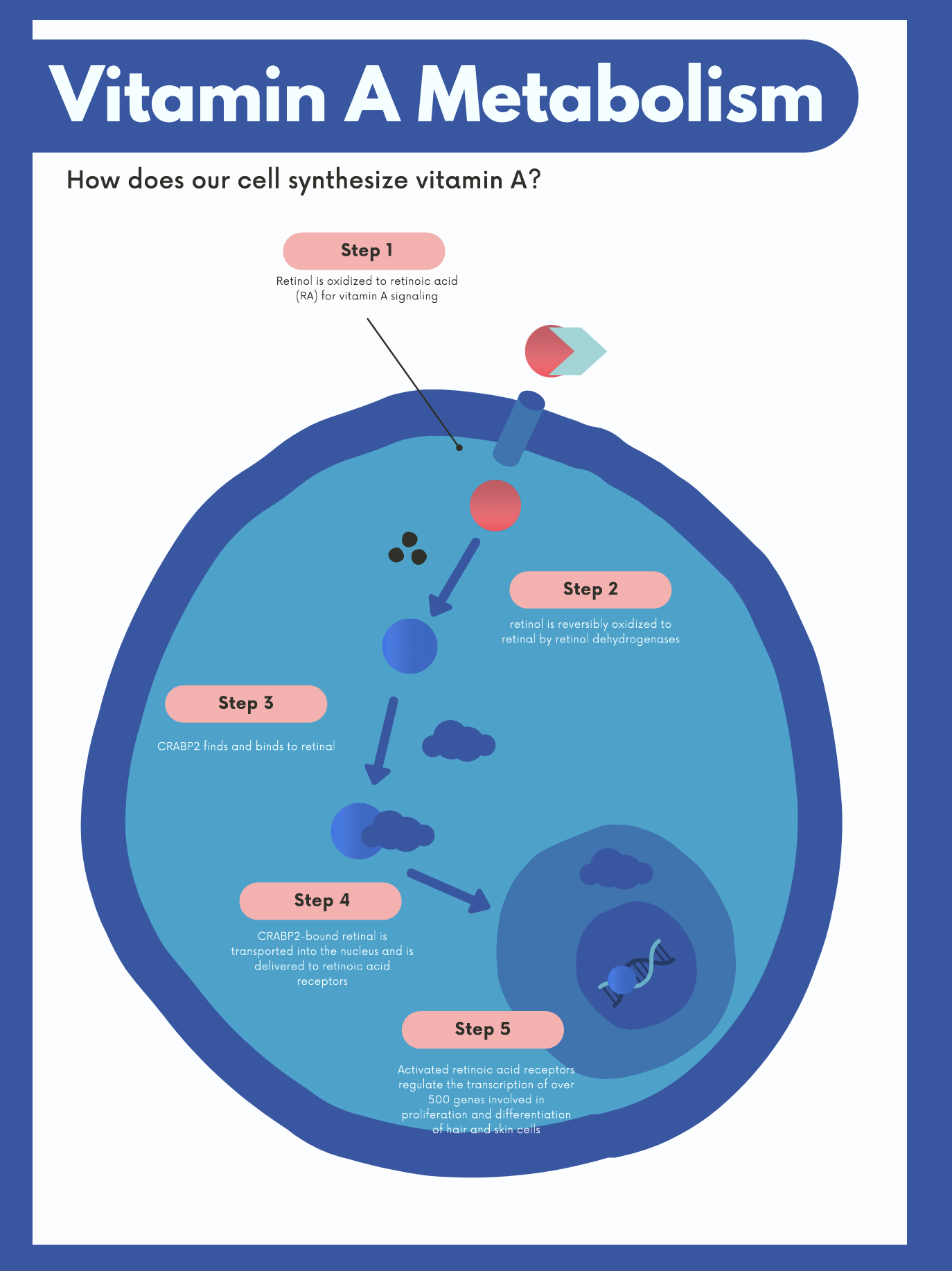Vitamin A is one of the essential fat soluble nutrients needed for the health of skin
and hair. Humans and other mammals are unable to synthesize vitamin A and must obtain
it from dietary sources. Vitamin A includes retinol, retinal, retinoic acid, retinyl
ester, and provitamin A carotenoids. Many skin diseases such as acne, psoriasis, and
skin cancers have been treated by using vitamin A and its synthetic derivatives,
retinoids. Retinoid resistance, genetic mutations, and side effects have been a
limiting factor for most patients from achieving desirable outcomes.
The active form of vitamin A is retinoic acid (RA). Retinoic acid is incorporated into
the cell by cellular retinoic acid binding proteins, one of which is known as CRABP2.
CRABP2 is a cytoplasmic binding protein in humans that is encoded by the CRABP2 gene and
expressed in differentiating cells in the epidermis and hair follicles. Hair growth is a
cycling process which consists of anagen (growing phase), catagen (cell death phase) and
telogen (resting phase). Telogen can be further separated into a refractory and a competent stage.
Transport of vitamin A is through an intracellular process. RA binds to CRABP2, transporting
this bound RA complex throughout the cell. RA is the active form of vitamin A and it needs to
be maintained at precise levels in the site of action. CRABP2-bound RA is transported into the
nucleus and delivered to retinoic acid receptors. When bound to the receptors in the nucleus,
RA activates the transcription of over 500 genes involved in cell proliferation and
differentiation. CRABP2 is also responsible for degrading any leftover RA to protect cells from
vitamin A toxicity. Therefore, homeostasis and sufficient amounts of the CRABP2 protein are
needed for adequate transport and development of cells.
The transition from telogen to anagen requires the activation and proliferation of stem cells
of the hair follicle bulge (HFSC). An excess or insufficient amount of vitamin A can alter the
proliferation of HFSC. A study conducted in mice found that CRABP2 was dose dependent on the
amount of vitamin A that was present. Thus suggesting that vitamin A may regulate HFSC in a dose
and time dependent manner. It is important to monitor and consult with a clinician on the
appropriate dose of vitamin A to be incorporated in order to treat alopecia.

The rs12724719 variation in the CRABP2 gene is associated with higher concentration of RA in the
blood, which is due to the decreased rate of intracellular transport of retinoic acid. If someone
is homozygous for allele A, (occurs in less than 20% of the population), this can potentially lead
to a lower efficacy of CRABP2 retinoic acid transportation in the cell. If the patient is
homozygotic, standard treatments with retinoic acid may not be sufficient. Therefore, clinicians at
Nimbus play a vital role in analyzing the presence of this genetic variation and tailor treatments
with the appropriate dose adjustments for therapy.
Skin plays an essential role in our health and maintaining homeostasis. Most importantly, it is a
reservoir for skin stem cells. These reservoirs include the hair follicle and the sebaceous gland.
The skin regulates the proliferation and differentiation of these skin cells, which is vital for wound
healing and regeneration. Abnormalities can lead to many skin disorders, such as skin cancers, delayed
wound healing, and alopecia.
References
Suo Liye, VanBuren Christine, Hovland Eylul Damla, Kedishvili Natalia Y., Sundberg John P.,
Everts Helen B. Dietary Vitamin A Impacts Refractory Telogen. Frontiers in Cell and Developmental
Biology. Volume 9. 2021. doi 10.3389/fcell.2021.571474
https://www.frontiersin.org/article/10.3389/fcell.2021.571474
Liye, VanBuren Christine, Hovland Eylul Damla, Kedishvili Natalia Y., Sundberg John P., Everts
Helen B. Dietary Vitamin A Impacts Refractory Telogen. Frontiers in Cell and Developmental Biology.
September 2021. Page 129.
https://www.frontiersin.org/article/10.3389/fcell.2021.571474.
doi 10.3389/fcell.2021.571474 Isoherranen, N., and Zhong, G. (2019). Biochemical and physiological importance of the CYP26 retinoic acid hydroxylases.
Pharmacol. Therapeut. 204:e107400
Orland, M. D., Anwar, K., Cromley, D., Chu, C. H., Chen, L. P., Billheimer, J. T., et al. (2005). Acyl coenzyme A dependent
retinol esterification by acyl coenzyme A : diacylglycerol acyltransferase 1. Biochim. Biophys.
Acta 1737, 76–82. doi: 10.1016/j.bbalip.2005.09.003
Boylan, J. F., and Gudas, L. J. (1992). The level of Crabp-I expression influences the amounts and
types of all-trans-retinoic acid metabolites in F9 teratocarcinoma stem-cells. J. Biol. Chem.
267, 21486–21491. doi: 10.1016/s0021-9258(19)36635-9
Chen, A. C., Yu, K., Lane, M. A., and Gudas, L. J. (2003). Homozygous deletion of the CRABPI
gene in AB1 embryonic stem cells results in increased CRABPII gene expression and decreased
intracellular retinoic acid concentration. Arch. Biochem. Biophys. 411, 159–173.
doi: 10.1016/s0003-9861(02)00732-4
Collins CA, Watt FM. Dynamic regulation of retinoic acid-binding proteins in developing,
adult and neoplastic skin reveals roles for beta-catenin and Notch signalling. Dev Biol.
2008;324(1):55-67. doi:10.1016/j.ydbio.2008. 08.034




